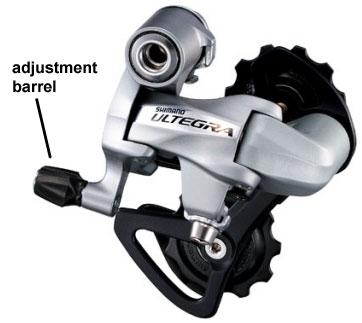Gear Change Problems?
With use it is normal for gear change cables to stretch. This is particularly so with new bikes, or after fitting a new cable. Cable stretch adversely affects gear changing, making changes noisy, slow and baulky. All too often the problem is made worse by ham fisted and incorrect adjustment of the gear cable. This can take two forms. One is to adjust the cable the wrong way, i.e. lengthen the cable instead of shorten. Or over correction by shortening too much. So here is the lowdown on how to fine tune the rear derailleur cable length so that you can whizz thru the gears, just like when your bike was new!
Roll Out The Barrel ( or is it roll in?)
For quick and smooth gear changes the gear cable requires the correct amount of tensioning. This is dependent on fine tuning of the cable length via its adjuster. Adjusting the cable length is a simple matter of turning the adjustment barrel by the correct amount and in the correct direction. The photo below shows a Shimano rear derailleur with the adjustment barrel marked. Note that the Shimano barrel is spring loaded and notched where it sits against the main housing. To turn, pull the (black) barrel away from the main housing, towards the rear of the bike. The notches allow accurate turning of the barrel in small, quarter turn increments.

Before you turn the adjustment barrel, make sure you have diagnosed the shifting issue correctly. In most cases the reason you reach for the adjuster is because the rear derailleur starts hesitating when shifting onto larger cassette cogs (lower (easier) gears). This is caused by the gear cable having stretched a little.
However, once in awhile you might run into the opposite problem: hesitation shifting onto the smaller cogs (higher gears). One thing that can cause this is someone overtightening a new shift cable during installation (or incorrect subsequent adjustment). Too much cable tension can be as bad as too little.
Wait, don’t turn it yet!
There are two more crucial things to get straight.
1.) You need to be sure you are turning the adjustment barrel in the correct direction.
2.) You should only turn it in 1/2-turn increments, then check the shifting to see how you are doing before turning it more.
If you count and keep track of the turns, you can then simply return it to where it was and start again if you happen to turn it the wrong way.
Okay, NOW you are ready to make the adjustment.
While standing behind the bike and looking down at the rear derailleur, to fix the most common problem – hesitation shifting into lower gears (larger cogs) – turn the adjuster anticlockwise. For the rarer problem – slow shifting into higher gears (smaller cogs) – turn it the other way, clockwise.
To help you to remember which way to turn the adjuster, he is a tip.
If the derailleur is slow shifting toward the spokes (changing into a lower gear), turn the adjuster toward the spokes.
If it’s slow shifting away from the spokes (changing to a higher gear), turn the adjuster away from the spokes.
Checking your adjustment
Have a friend hold up your bicycle if you’re not lucky enough to be working on it in a repair stand, and test the shifting to see how your adjustment worked. Usually with only a full turn or a turn and a half you can add enough tension to a stretched cable to restore perfect shifting. When it’s right, each shift/click of the lever will move the chain quickly onto the next cog and there will be no noise or rubbing in any gear.
If there are two of you, one person can shift and pedal by hand and the other person can sight the derailleur and listen to tell if the chain is dead center on each cog, or see if you need to turn the adjuster one notch more.
In most cases, fine-tuning the rear derailleur with the adjustment barrel takes only a few minutes at the most, and quickly puts a smile back on the rider’s face. So have fun with this important adjustment.
There are a number of reasons, other than cable stretch, which can cause more serious gear changing problems. These are due to wear and tear, damaged parts, or lack of maintenance. Cable adjustment alone, will not fix these problems! This short item is about correcting cable stretch or fine tuning an incorrectly set cable adjustment.
This item is an edited version of one which appeared in a Roadbike Rider Newsletter . These weekly newsletters have many interesting and informative articles on various bike related topics.

